RV Decals
RV decals come in many shapes, sizes, and materials. Often what is looked at as a decal, is really painted graphics. Our first goal will be to identify the various types of RV graphics and decals you might come across.
Once we have determined what type of decals we are working with, then we can discuss care and maintenance of the decals you might find on your motorhome, toy trailer, RV, etc.
My experience has shown that most people confuse the various types of graphics, and therefore remain confused as to what is considered proper care of these visual enhancements.
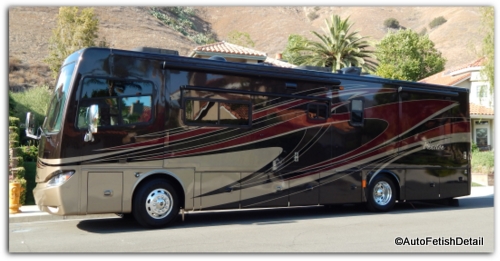 Here is a shot of a Phaeton diesel pusher RV with full body paint
Here is a shot of a Phaeton diesel pusher RV with full body paint- How do you determine if your RV has decals or full body paint?
- Do RV decals need to be waxed?
- What kind of wax can I you use on your RV decals?
- Can the same wax I use on my RV siding be used on the vinyl decals?
RV Decals:
Not all decals are created equal
Virtually every RV, toyhauler, 5th wheel, or trailer will have some form of graphics. The only exception that could possibly be argued are the high-end RV's with full-body paint.
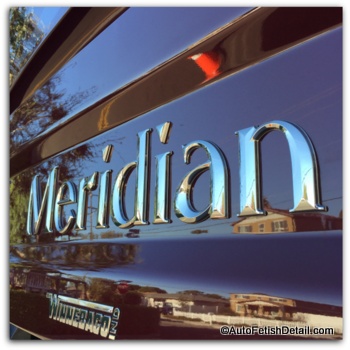
But even these rolling behemoths that can cost more than many people's homes will have trivial amounts of "decals" or embellishments.
These subtle embellishments can come in many types of materials and are usually limited to the RV brand and model. The RV is fully painted, clear coated, and then any additional identification will be added in the form of some type of decal material.
This example from a Winnebago Meridian RV is an extreme example of how RV manufacturers can take "RV decals" to a whole new level.
This embellishment could hardly be labeled as an RV vinyl decal. This is on a high-end diesel pusher RV manufactured by Winnebago who installed chrome plated, plastic emblems to designate the brand and model of this RV.
RV Decal Identification:
Many colors, many finishes, many brands
There simply is no limit to the types of RV decals used in the final construction process of manufacturing RV's of ANY kind.
This RV below is a perfect example illustrating the many types of decals you can and will encounter.
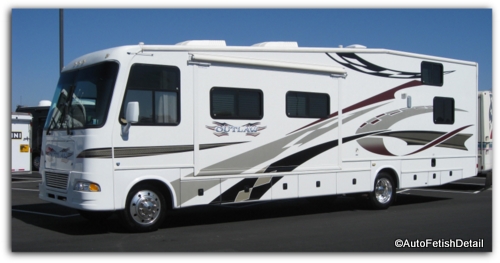
- Different colors
- Different sizes/lengths
- Different textures
- Different manufacturers
While you may think I am making something as basic as RV decals, more complex than is needed, the reality is that everyone one of those variables makes a difference.
And when I say difference, I am referring to how the specific RV decal ages and weathers. The size, color, material will all be determinants in how your particular RV decals will age.
The Decals on Your RV:
The aging process
The RV vinyl decals below are a perfect example of how two decals, that are almost identical in shape and size, but are different colors have aged differently.
The maroon RV decal is peeling at the edges while the black RV decal remains intact.
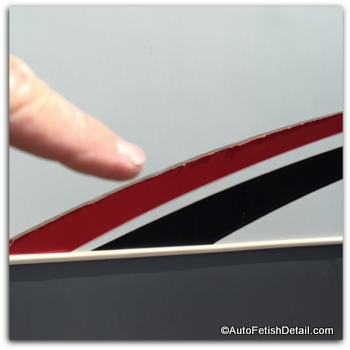
The most critical thing to understand is that your RV will have a variety of decals and graphics. Each decal is truly unique based on how the decal was made.
Like anything in life, nothing is truly created equal. Since decals are really a way to "spice-up" a rather boring thing called your RV, RV manufacturers as a rule will outsource the decals to the cheapest decal manufacturer.
While every decal known to man will have a shelf life, the decals on your RV have a rather short shelf life due to inferior materials. Quality decals that are designed to truly last a life-time (this is a very relative statement) will be finished with a clear, protective UV coating.
These decals are not the kind you generally find adorning the sides of any RV. Decals made to this level of quality cost vastly more to produce than basic, vinyl decals with little to no protective UV coating.
Rv's and RV Decals:
Not everything is created equally
As we have learned about the decals on RV's, it is also important to note the differences in the RV itself. When you are looking how to maintain and protect the decals on your RV, it will be necessary to understand the differences in your RV.
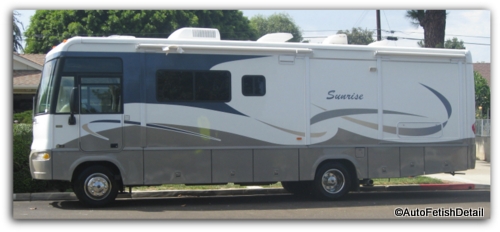
After all, any RV vinyl decal will officially be attached to the material your RV is actually constructed with. And once again; not all materials are created equal.
There are some very common questions people have in regards to the decals used on RV's which I will cover for you:
- Can you wax RV decals?
- Should you wax RV decals?
What kind of polish would you use on RV decals? - Can you actually polish RV decals?
These are the most frequently asked questions from RV owners as a detailing professional.
Difference Between Gel Coat and Fiberglass
This is a topic as confused as the topic of decals on your RV. One of the most common questions presented to me by RV owners is how to take care of the decals on their RV.
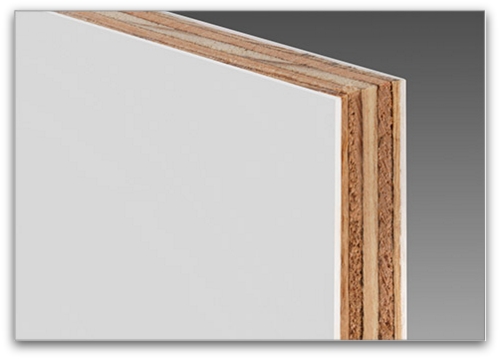
Before I can offer a solution to that need, I would have to know how that particular RV has been made. Many people misuse these two terms or labels due to lack of understanding.
Some people refer to their RV as gel coat and some call it fiberglass. What people call "it", is not the most critical part. The most important part is to understand how your RV particular RV is "finished".
Only by properly identifying the surface material(s), will you be able to move forward with a game plan using proper products and techniques. (So far we have discussed gel coat/fiberglass, vinyl decals, paint)
As can be seen in this cut-away of what is often called FRP (fiberglass reinforced plywood), this is the basic materials used in constructing most RV's. These represent the side walls, with the front and end caps of most RV's being formed within a mold.
It is referred to as a modular way of construction. The different components or module's are constructed, then assembled together for the completed RV.
"Gel coat is not fiberglass. Fiberglass is not gel coat. But often the two materials are used together"
Gel coat is a polyester or epoxy resin that is mixed together as separate liquids. Once they are mixed together, they catalyze (become hard) and cross-link together forming a very durable layer.( a simple comparison or analogy would be to think of a typical boat or bath tub. Both boats and bath tubs are formed inside a separate mold)
White pigment is added to this polyester or epoxy resin to add color. Any color could be officially used, but white is the preferred color due to its forgiving nature. White naturally hides many blemishes better than any other color. This includes the oxidation that develops far easier and quicker than you likely imagine.
If RV manufacturers actually left your RV without any added embellishments in the form of vinyl decals, you would be driving around in a rather boring, oversized white box.
This means that plywood (or some other wood) is the core material, then fiberglass cloth is laid down, at which point the chosen polyester or epoxy resin is applied over the fiberglass cloth.
The fiberglass cloth is saturated with the resin to form a very durable top coat. It is the fact that both fiberglass (in the form of cloth or particles) and the gel coat resin is used that confusion arises.
Darren's Note: From here on out, now that we have learned that regardless of whether your RV has been constructed with any form of fiberglass or not, the very top layer will always be some form of gel coat resin. I will refer to this material as gel coat for the remainder of this page.
RV Paint, Gel Coat, Decals:
Why it matters
It matters a lot!
It matters not just because of your RV decals, but because of the material on which your decals are laid onto.
The RV below is your high-end RV due to the fact that it has full body paint. All the various graphics have been painted and then the entire RV is clear coated. This is the same process as car paint which is called 2-stage paint or clear coated paint. (the color coat is the 1st stage and the clear coat is the 2nd stage)
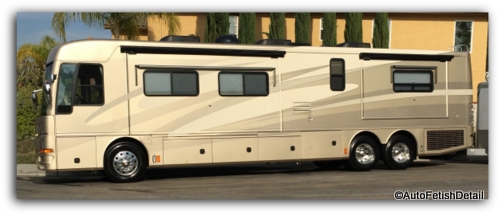
RV Partial or Full Body paint:
- This will be what is called 2-stage paint
- This means it will have a clear coat as the top layer (think of this simply as paint with no pigment to it)
- Clear coat does not oxidize like bare gel coat does
- Clear coat does not become chalky, dull, and "porous" as does gel coat as it ages
Darren's Note: What this literally means to you is that you are working on an oversized car. Any product, technique, or tool you would use to take care of the exterior of your car, could be used on your RV with full body paint; or any of the smaller, isolated areas of your RV that have been painted.
Gel Coat:
- Gel coat oxidizes extremely easy regardless of where it is stored (outdoor storage will greatly accelerate the oxidation process)
- Decals will age at different rates than the gel coat or paint of which they are applied to
Decals:
- Your RV or trailer will have various kinds of decals: color, shape, size, and texture
- Each decal will potentially age differently than the other decals on your RV
- Decals can come in a variety of finishes: matte, high-gloss, low-gloss, smooth, textured, chromed, etc.
- Just like any material exposed to the elements, decals of any kind will age and degrade the older they become and the more they are exposed to the elements
- Decals can and should be waxed to extend their natural "shelf-life"
Waxing Your RV and Waxing Decals
Every one of you will come to this page with different questions and totally unique situations. Your RV is like no other in every way. For this reason I will start with the most common situation and go from there.
Gel Coat RV's w/ Decals:
Since these are the most common type of RV's due to their more entry level cost, I will address these type of RV's.
"The biggest problem with these RV's is the fact that gel coat oxidizes so easily and it is virtually impossible to polish or wax the gel coat without getting that polish or wax on the decals"
The accepted rule is that most waxes and polishes will stain and discolor decals found on RV's. This is the accepted rule. But despite the rules, there always remain exceptions to the rules.
Darren's Rules of Decals:
- Decals cannot be polished back to life
- Decals should be wax just like your RV should be waxed for protection against the elements
- Traditional polishes and waxes will discolor or stain decals
Darren's Exception to the Rules of Decals:
- Since not all decals are created the same: smooth, glossy decals can usually be waxed or even polished in most cases with any type of traditional polish or wax
- Any decal that is not very smooth and glossy (in it's original state) will prove problematic if you attempt to wax or polish with a traditional car wax or car polish (these means any decal with even the most subtle of texture or was not originally a high-gloss material)
- There are wax products that are non-staining and can literally be used on any type of decal regardless of color, age, texture, etc.
Answering the above questions often leave you as an RV owner wondering if you can polish RV decals to restore and protect them like you can the paint or the gel coat surface of your RV.
Sometimes....You never know until you know. Even as an expert, I will not know what results I can produce when I attempt to polish RV decals until I do it. I work under the same rules and the same exceptions to the rules that I have laid out her for you.
Let's look at some of the many examples of RV's as well as the decals used on RV's:
Corrugated Aluminum RV with Vinyl Decals
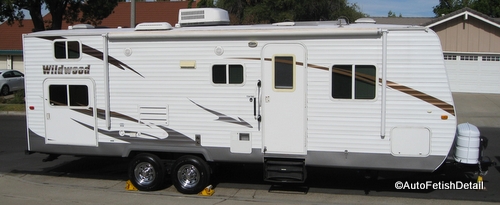
The above RV trailer is the worst of the worst due to the fact that is has uneven siding in the form of corrugated panels. This corrugated RV trailer is built using baked enamel corugated panels with vinyl decals.
These types of RV's are as difficult to maintain as anything can get. Not only will the baked enamel corrugated siding be problematic enough, but you also have the RV decals to contend with.
There are both aluminum (painted) and fiberglass (molded) corrugated versions of these types of RV trailers. I have yet to see corrugated panels used on any type of RV other than on RV trailers.
White Gel Coat With Paint and Decals
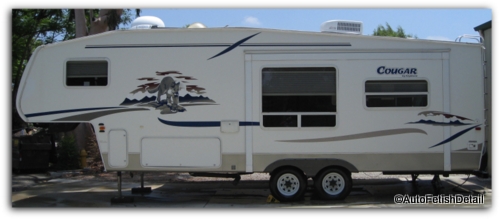
Here we have a 5th RV that is made the same way any traditional RV is with the fiberglass reinforced siding, completed with white gel coat. The extreme lower section has been painted a champagne color.
White Gel Coat with Paint and Decals
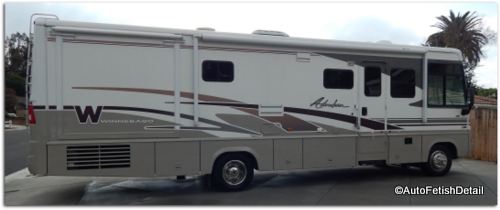
This Winnebago is a combination of bare fiberglass siding, painted areas, with vinyl decals.
RV With Full Body Paint
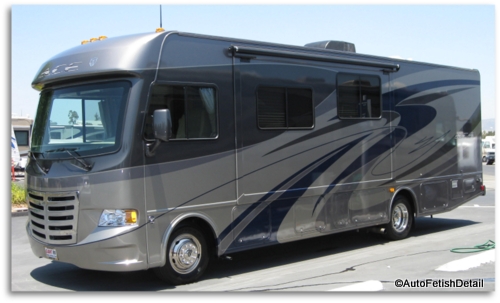
Here we have a full body paint RV. The RV is assembled, the graphics are laid out and painted, then the entire custom paint scheme is clear coated. Despite these RV's costing more than non-painted versions, the full body paint RV's are the easiest to take care of.
Once again, these are like over-sized cars.
Taking Care of Your New RV:
What Would Darren Do (WWDD)
Taking care of a brand new RV represents the easiest of challenges regardless of the type of RV you have and regardless of the type of decals on your RV.
Often people simply ask what I would do. You may be one of those people who want an simple, straightforward solution to your needs.
Oxidized RV's:
What Would Darren Do (WWDD)
Since many of you coming to this page will be dealing with an RV that has oxidation to the gel coat as well as RV decals that have also become weathered, any traditional RV wax or car wax product will not be a good option for you.
Not only will that wax product prove ineffective, but if you choose the wrong wax product, you can actually create a bigger problem for yourself.
While there may be many of you that have an RV so severely oxidized it is past the point of no return, there are products you can use to at least improve the overall appearance of your RV while putting some form of protection on it.
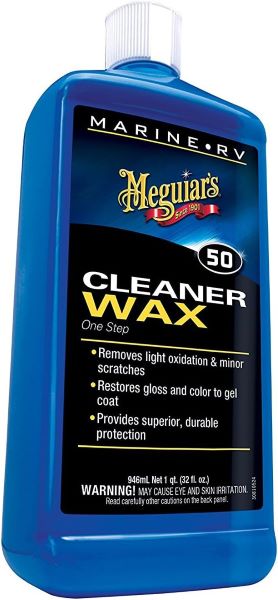
Meguiar's Marine/RV Cleaner Wax on Amazon
- This is my recommended "go-to" product for any RV you think has any degree of oxidation (which will be pretty much all of you reading this page)
- Can be used on both gel coat or painted surfaces
- Remove light levels of oxidation while restoring gloss and adding protection
- Can be used by hand or machine
Darren's Tips: This product by the well known Meguiar's is a perfect product to start with in almost any situation if you are dealing with an RV that is not brand new. Gel coat oxidizes very quickly and easily. For that reason, even if your RV still looks very shiny it will most likely have even a subtle amount of oxidation. This subtle amount of oxidation will quickly reveal itself if you attempt to wax your RV with a traditional wax product.
As far as your RV decals go; this product can be used on some RV decals, but it is a case by case judgment call. You need to test and assess on each of the RV decals you are attempting to restore and protect.
If at first this product does not produce the results you want, repeat until you either give up, or you achieve desired results. Gel coat is a tricky beast to work with and there is no set rule that can be applied for every situation.
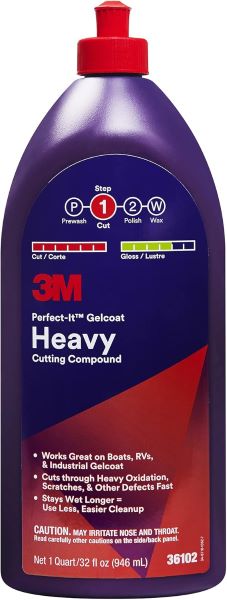
3M Heavy Cut Compound on Amazon
- For situations where oxidation is too severe for the cleaner wax product above
- Removes heavier levels of oxidation, scratches, and imperfections
- Formulated to be used on gel coat material specifically (RV, boat, watercraft, etc.)
- Can be used by hand of machine
Darren's Tips: When you know you have heavy layers of oxidation, you will need to reach for a product like this. Use repeat applications by hand or machine until you have achieved desired results.
This is a true, professional grade compound for heavy duty oxidation removal. This is one of my "go-to" compounds when working on heavily oxidized RV's or boats.
Not recommended for use on RV decals, but ultimately this is a case by case judgement call on your part if your have RV decals that need some restoring to them. You simply need to experiment and test. Test and assess!
You will need to apply a wax product after using this compound.
RV Decal Summary
RV decals are a sore subject for most RV owners. They are useful for enhancing the appearance of your RV, but are sure a pain in the but to deal with. It is hard to discuss proper care and protection of RV decals without the subject naturally bleeding over into the topic of general RV care.
My goal has been to provide you with useful information as well as product recommendations to help you achieve what you are after.
I wish you much success!
Sincerely,
Darren Priest
|
|
